DEM Study on the Segregation of a Non-Spherical Intruder in a Vibrated Granular Bed
Abstract
:1. Introduction
2. Materials and Methods
2.1. Model Description
2.2. Simulation Conditions and Validation
2.3. Evaluation Indexes
3. Results and Discussion
3.1. Effects of Vibration Amplitude on va
3.2. Effects of Vibration Frequency on va
3.3. Modeling of Ascending Velocity
4. Conclusions
Author Contributions
Funding
Institutional Review Board Statement
Informed Consent Statement
Data Availability Statement
Acknowledgments
Conflicts of Interest
References
- Shinbrot, T.; Shinbrot, T. Granular materials: The Brazil nut effect--in reverse. Nature 2004, 429, 352–353. [Google Scholar] [CrossRef]
- Breu, A.; Ensner, H.M.; Kruelle, C.A.; Rehberg, I. Reversing the Brazil-nut effect: Competition between percolation and condensation. Phys. Rev. Lett. 2003, 90, 143021. [Google Scholar] [CrossRef] [Green Version]
- Williams, J.C.; Shields, G. The segregation of granules in a vibrated bed. Powder Technol. 1967, 1, 134–142. [Google Scholar] [CrossRef]
- Rosato, A.; Strandburg, K.J.; Prinz, F.; Swendsen, R.H. Why the Brazil nuts are on top: Size segregation of particulate matter by shaking. Phys. Rev. Lett. 1987, 58, 1038–1040. [Google Scholar] [CrossRef]
- Walliser, H. Comment on “Reverse Brazil Nut Problem: Competition between Percolation and Condensation”. Phys. Rev. Lett. 2001, 89, 189603. [Google Scholar] [CrossRef] [Green Version]
- Möbius, M.E.; Lauderdale, B.E.; Nagel, S.R.; Jaeger, H.M. Brazil-nut effect: Size separation of granular particles. Nature 2001, 414, 270. [Google Scholar] [CrossRef]
- Huerta, D.A.; Ruiz-Suárez, J.C. Vibration-Induced Granular Segregation: A Phenomenon Driven by Three Mechanisms. Phys. Rev. Lett. 2004, 92, 114301. [Google Scholar] [CrossRef] [Green Version]
- Duran, J.; Rajchenbach, J.; Clément, E. Arching effect model for particle size segregation. Phys. Rev. Lett. 2003, 70, 2431–2434. [Google Scholar] [CrossRef]
- Yan, X.; Shi, Q.; Hou, M.; Lu, K.; Chan, C.K. Effects of Air on the Segregation of Particles in a Shaken Granular Bed. Phys. Rev. Lett. 2003, 91, 14302. [Google Scholar] [CrossRef] [Green Version]
- Shinbrot, T.; Muzzio, F.J. Reverse Buoyancy in Shaken Granular Beds. Phys. Rev. Lett. 1998, 81, 4365–4368. [Google Scholar] [CrossRef]
- Nahmad-Molinari, Y.; Canulchay, G.; Ruizsuárez, J.C. Inertia in the Brazil nut problem. Phys. Rev. E 2003, 68, 352–375. [Google Scholar] [CrossRef] [PubMed] [Green Version]
- Vanel, L.; Rosato, A.D.; Dave, R.N. Rise-Time Regimes of a Large Sphere in Vibrated Bulk Solids. Phys. Rev. Lett. 1997, 78, 1255–1258. [Google Scholar] [CrossRef]
- Tai, C.H.; Hsiau, S.S.; Kruelle, C.A. Density segregation in a vertically vibrated granular bed. Powder Technol. 2010, 204, 255–262. [Google Scholar] [CrossRef]
- Lim, E.W.C. Density segregation in vibrated granular beds with bumpy surfaces. AICHE J. 2010, 56, 2588–2597. [Google Scholar] [CrossRef]
- Shi, Q.; Sun, G.; Hou, M.; Lu, K. Density-driven segregation in vertically vibrated binary granular mixtures. Phys. Rev. E Stat. Nonlin. Soft Matter Phys. 2007, 75, 61302. [Google Scholar] [CrossRef] [PubMed]
- Jain, A.; Metzger, M.J.; Glasser, B.J. Effect of particle size distribution on segregation in vibrated systems. Powder Technol. 2013, 237, 543–553. [Google Scholar] [CrossRef]
- Krouskop, P.E.; Talbot, J. Studies of Mass and Size Effects in Three-Dimensional Vibrofluidized Granular Mixtures. Phys. Rev. E Stat. Nonlin. Soft Matter Phys. 2003, 68, 21304. [Google Scholar] [CrossRef] [Green Version]
- Haff, P.K.; Werner, B.T. Computer simulation of the mechanical sorting of grains. Powder Technol 1986, 48, 239–245. [Google Scholar] [CrossRef]
- Schröter, M.; Swinney, H.L.; Ulrich, S. Influence of friction on granular segregation. Phys. Rev. E 2007, 76, 42301. [Google Scholar]
- Bose, M.; Rhodes, M. Dynamics of an intruder in a shaken granular bed. Powder Technol. 2007, 179, 25–30. [Google Scholar] [CrossRef]
- Rosato, A.; Prinz, F.; Strandburg, K.J.; Swendsen, R.H. Monte Carlo Simulation of Particle Matter Segregation. Powder Technol. 1986, 49, 59–69. [Google Scholar] [CrossRef]
- Liffman, K.; Muniandy, K.; Rhodes, M.; Gutteridge, D.; Metcalfe, G. A segregation mechanism in a vertically shaken bed. Granul. Matter 2001, 3, 205–214. [Google Scholar] [CrossRef]
- Knight, J.B.; Jaeger, H.M.; Nagel, S.R. Vibration-induced size separation in granular media—The convection connection. Phys. Rev. Lett. 1993, 70, 3728–3731. [Google Scholar] [CrossRef]
- Hirt, C. Size Segregation and Convection. Europhys. Lett. 1995, 29, 123–128. [Google Scholar]
- Burtally, N.; King, P.J.; Swift, M.R.; Leaper, M. Dynamical behaviour of fine granular glass/bronze mixtures under vertical vibration. Granul. Matter 2003, 5, 57–66. [Google Scholar] [CrossRef]
- Ahmad, K.; Smalley, I.J. Observation of particle segregation in vibrated granular systems. Powder Technol. 1973, 8, 69–75. [Google Scholar] [CrossRef]
- Kock, I.; Huhn, K. Influence of particle shape on the frictional strength of sediments—A numerical case study. Sediment Geol. 2007, 196, 217–233. [Google Scholar] [CrossRef]
- Jha, A.K.; Gill, J.S.; Puri, V.M. Percolation Segregation in Binary Size Mixtures of Spherical and Angular-Shaped Particles of Different Densities. Part. Sci. Technol. 2008, 26, 482–493. [Google Scholar] [CrossRef]
- Fernando, D.N.; Wassgren, C.R. Effects of vibration method and wall boundaries on size segregation in granular beds. Phys. Fluids 2003, 15, 3458. [Google Scholar] [CrossRef]
- Hsiau, S.; Yu, H. Segregation phenomena in a shaker. Powder Technol. 1997, 93, 83–88. [Google Scholar] [CrossRef]
- Jiang, Z.; Jing, Y.; Zhao, H.; Zheng, R. Effects of subharmonic motion on size segregation in vertically vibrated granular materials. Acta Phys. Sin. 2009, 58, 5923–5929. [Google Scholar]
- Liu, Y.; Zhao, J. A model for the Brazil-nut segregation time. Granul. Matter 2015, 17, 265–270. [Google Scholar] [CrossRef]
- Peng, Y.; Zhang, Z.; Wang, Y.; Liu, X. Experimental and theoretical investigations of the effect of “Brazil Nut” segregation in vibrating granular matters. Acta Phys. Sin. 2012, 61, 279–286. [Google Scholar]
- Qiao, J.; Wen, P.; Duan, C.; Wang, W. Particle behavior and parameter optimization in treatment of waste petroleum reforming catalysts based on a compound dry separator. Adv. Powder Technol. 2020, 31, 1181–1195. [Google Scholar] [CrossRef]
- Qiao, J.; Huang, L.; Duan, C.; Jiang, H.; Zhao, Y.; Shao, H.; Pan, M. Research on separation mechanism of waste palladium catalyst in a structure-optimized compound dry separator based on DEM-CFD. Part. Sci. Technol. 2020, 38, 131–143. [Google Scholar] [CrossRef]
- Qiao, J.; Duan, C.; Jiang, H.; Zhao, Y.; Chen, J.; Huang, L.; Wen, P.; Wu, J. Research on screening mechanism and parameters optimization of equal thickness screen with variable amplitude based on DEM simulation. Powder Technol. 2018, 331, 296–309. [Google Scholar] [CrossRef]
- Dong, K.; Esfandiary, A.H.; Yu, A.B. Discrete particle simulation of particle flow and separation on a vibrating screen: Effect of aperture shape. Powder Technol. 2017, 314, 195–202. [Google Scholar] [CrossRef]
- Liu, C.; Wang, H.; Zhao, Y.; Zhao, L.; Dong, H. DEM simulation of particle flow on a single deck banana screen. Int. J. Min. Sci. Technol. 2013, 23, 273–277. [Google Scholar] [CrossRef]
- Elperin, T.; Golshtein, E. Effects of convection and friction on size segregation in vibrated granular beds. Phys. A Stat. Mech. Its Appl. 1997, 247, 67–78. [Google Scholar] [CrossRef]
- Qiao, J.; Duan, C.; Dong, K.; Wang, W.; Jiang, H.; Zhu, H.; Zhao, Y. DEM study of segregation degree and velocity of binary granular mixtures subject to vibration. Powder Technol. 2021, 382, 107–117. [Google Scholar] [CrossRef]
- Amirifar, R.; Dong, K.; Zeng, Q.; An, X. Self-assembly of granular spheres under one-dimensional vibration. Soft Matter 2018, 18, 9856–9869. [Google Scholar] [CrossRef]
- Amirifar, R.; Dong, K.; Zeng, Q.; An, X. Bimodal self-assembly of granular spheres under vertical vibration. Soft Matter 2019, 15, 5933–5944. [Google Scholar] [CrossRef]
- Hu, K.; Xie, Z.A.; Wu, P.; Sun, J.; Li, L.; Jia, C.; Zhang, S.; Liu, C.; Wang, L. Convecting particle diffusion in a binary particle system under vertical vibration. Soft Matter 2014, 10, 4348–4359. [Google Scholar] [CrossRef]
- Wildman, R.D.; Huntley, J.M. Novel method for measurement of granular temperature distributions in two-dimensional vibro-fluidised beds. Powder Technol. 2000, 113, 14–22. [Google Scholar] [CrossRef]
- Tai, C.H.; Hsiau, S.S. Dynamic behaviors of powders in a vibrating bed. Powder Technol. 2004, 139, 221–232. [Google Scholar] [CrossRef]
- Hsiau, S.S.; Lu, L.S.; Tai, C.H. Experimental investigations of granular temperature in vertical vibrated beds. Powder Technol. 2008, 182, 202–210. [Google Scholar] [CrossRef]
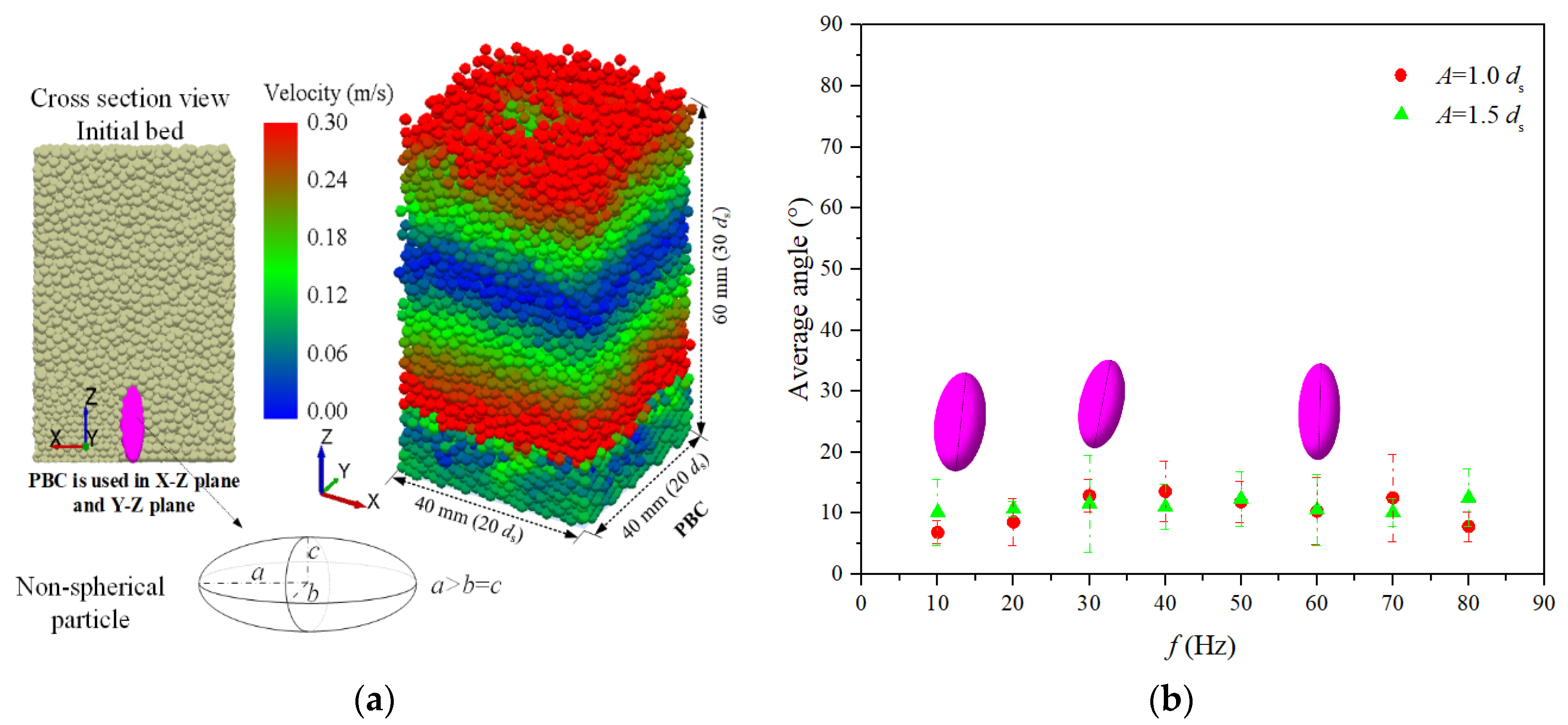
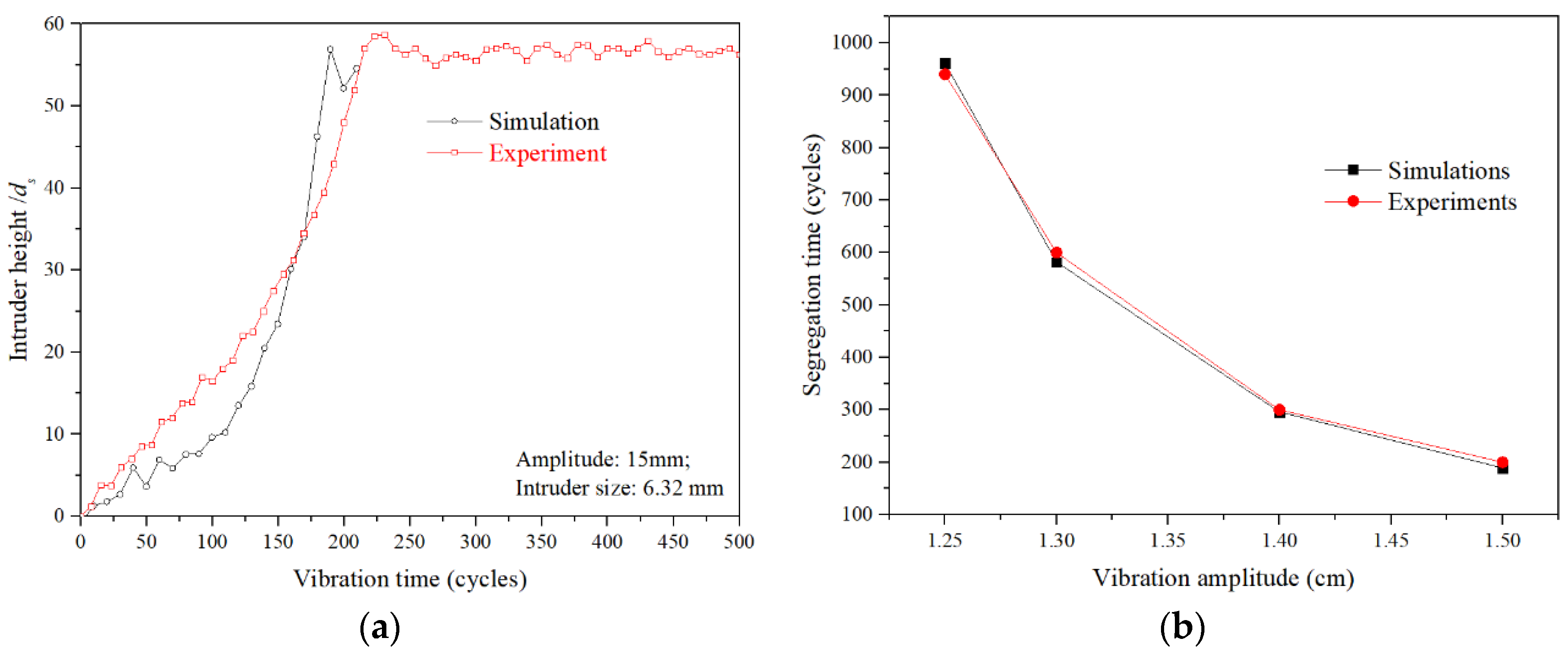

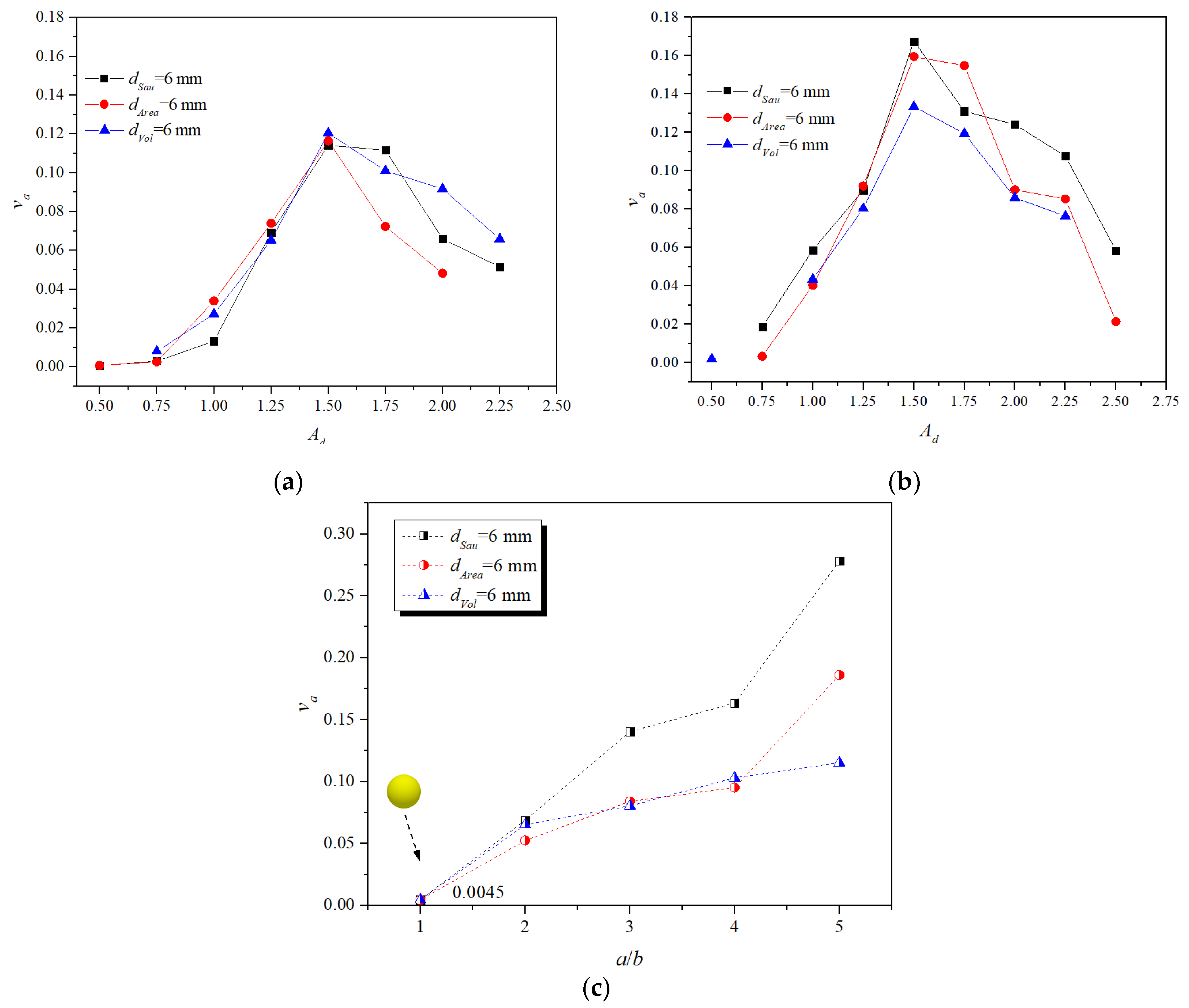

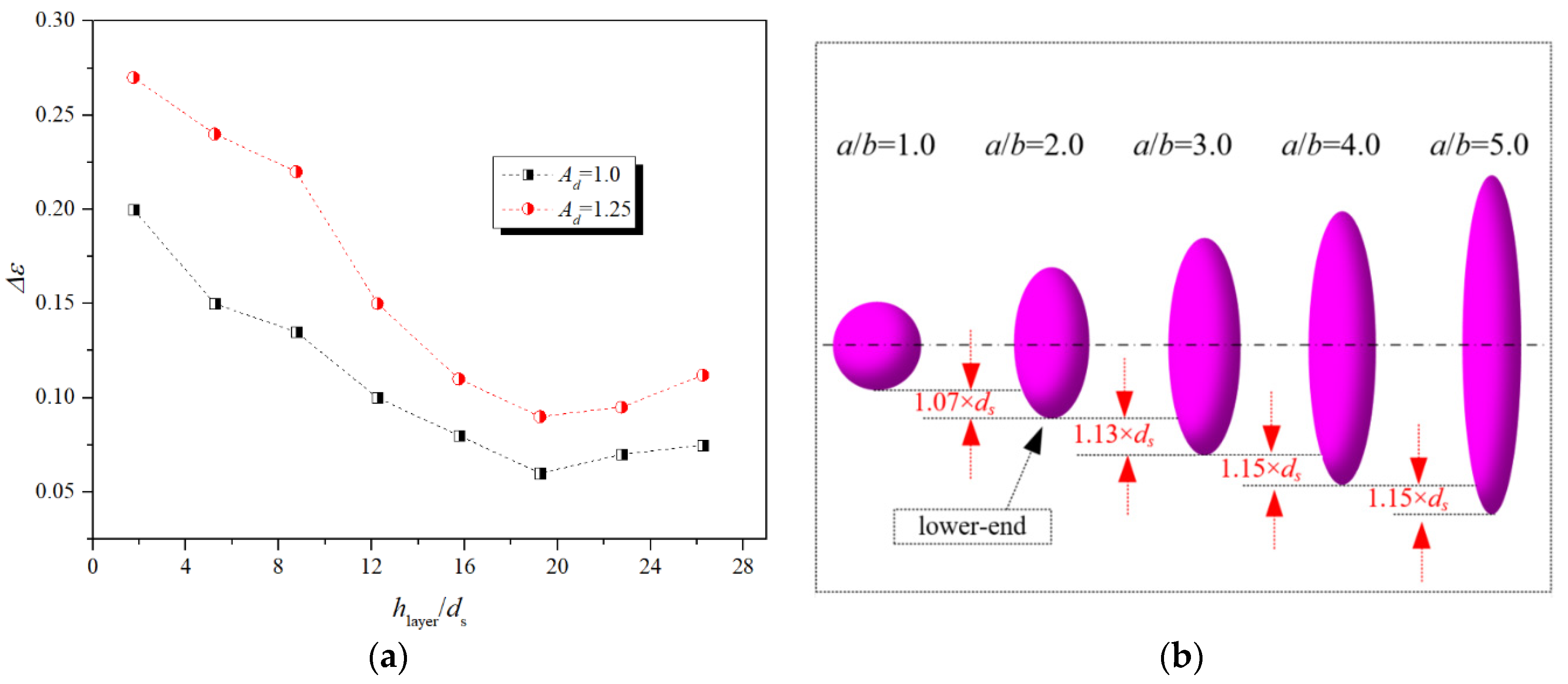
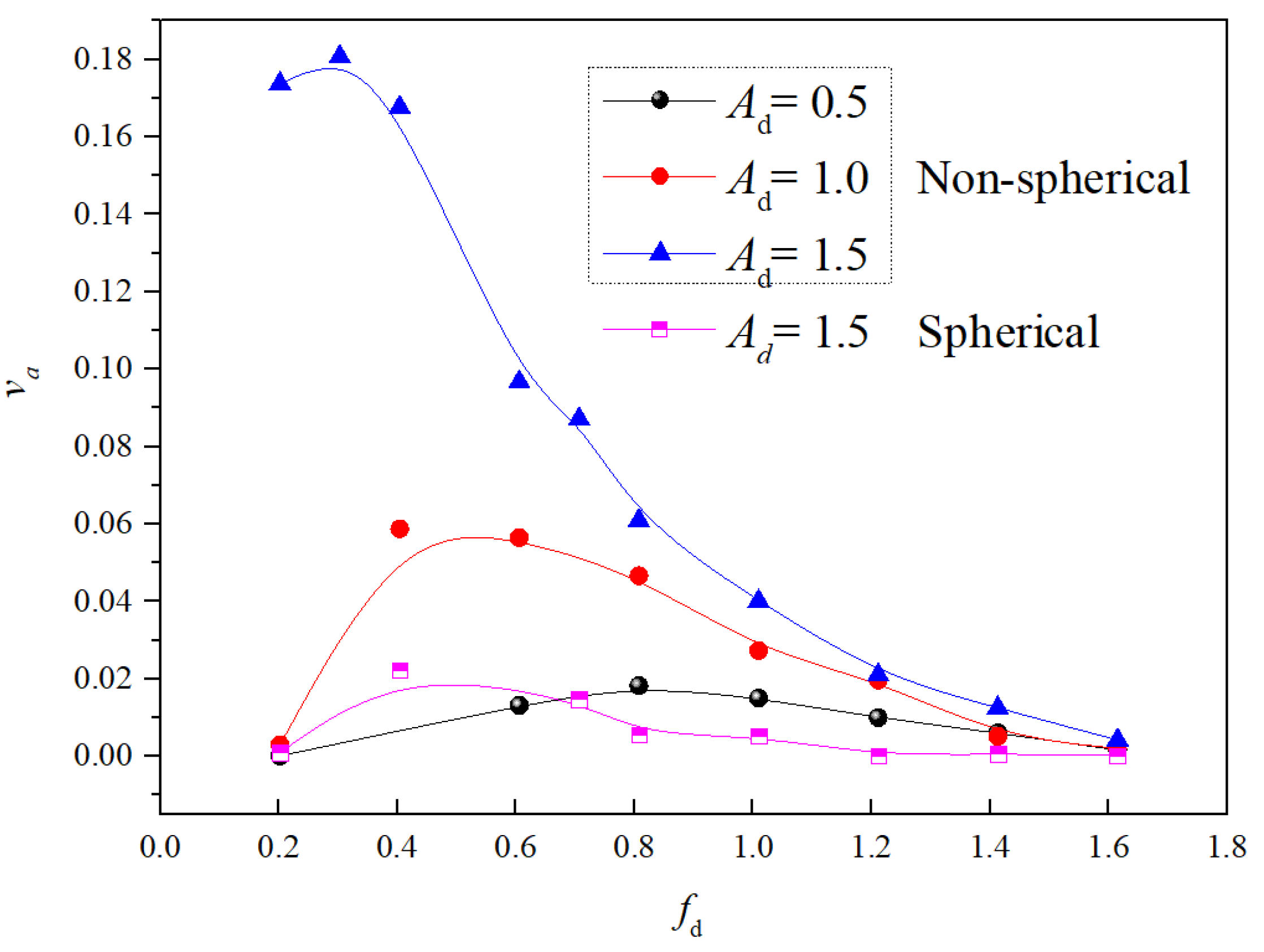


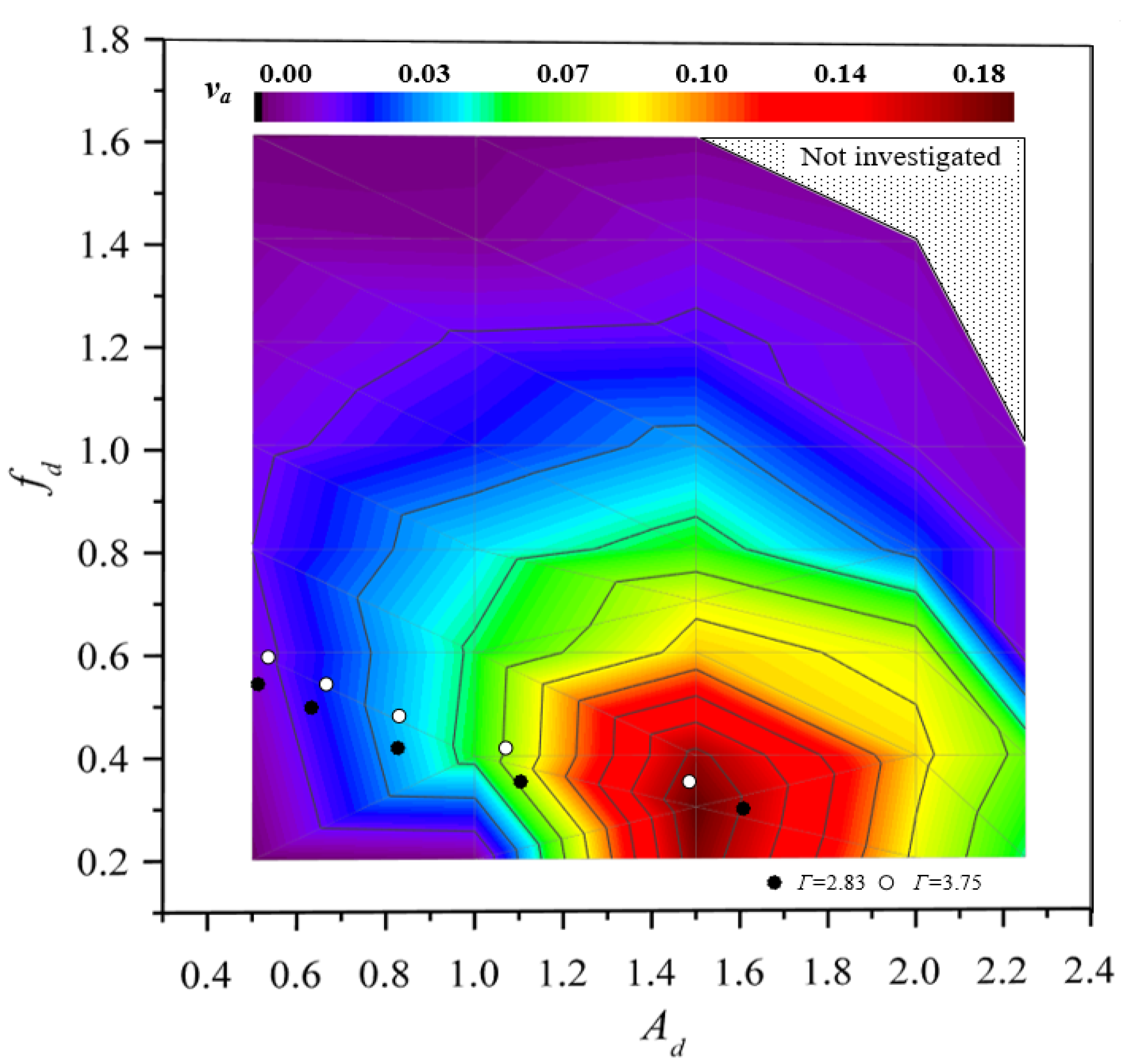
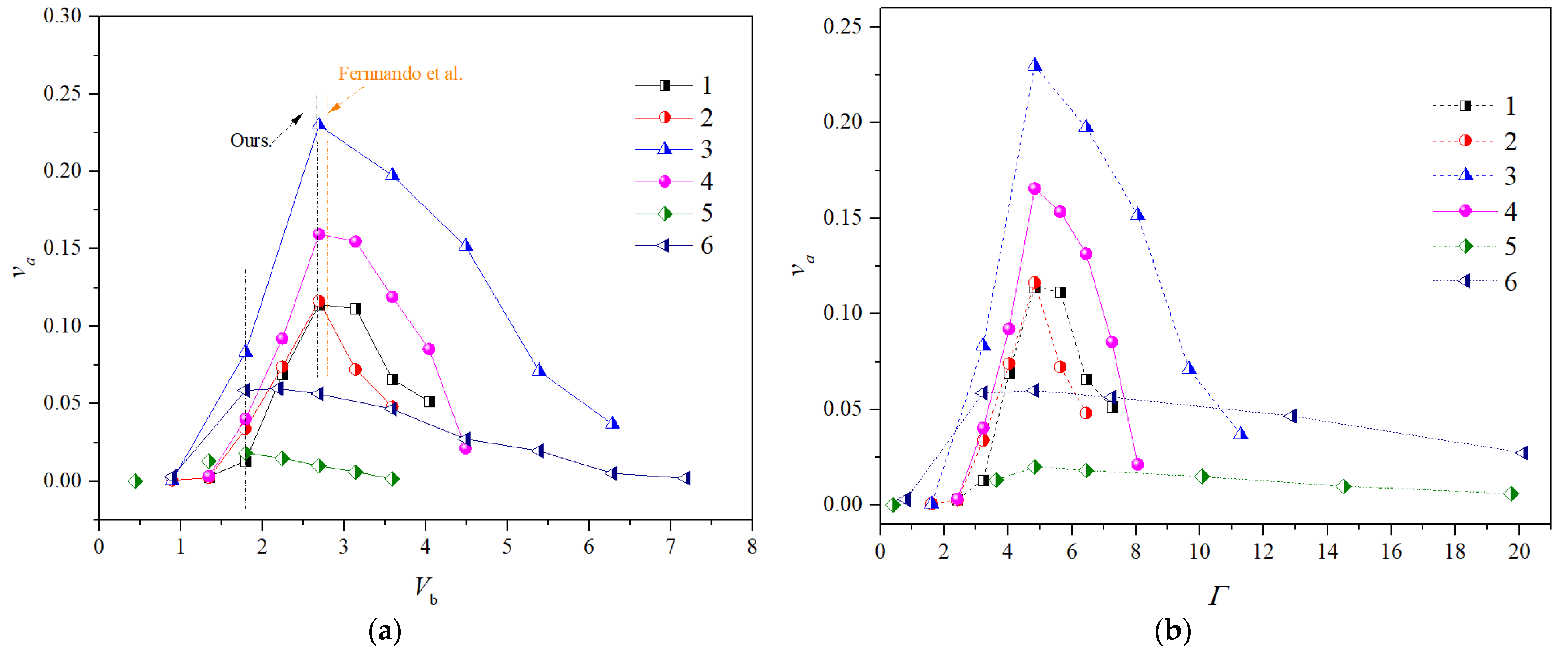

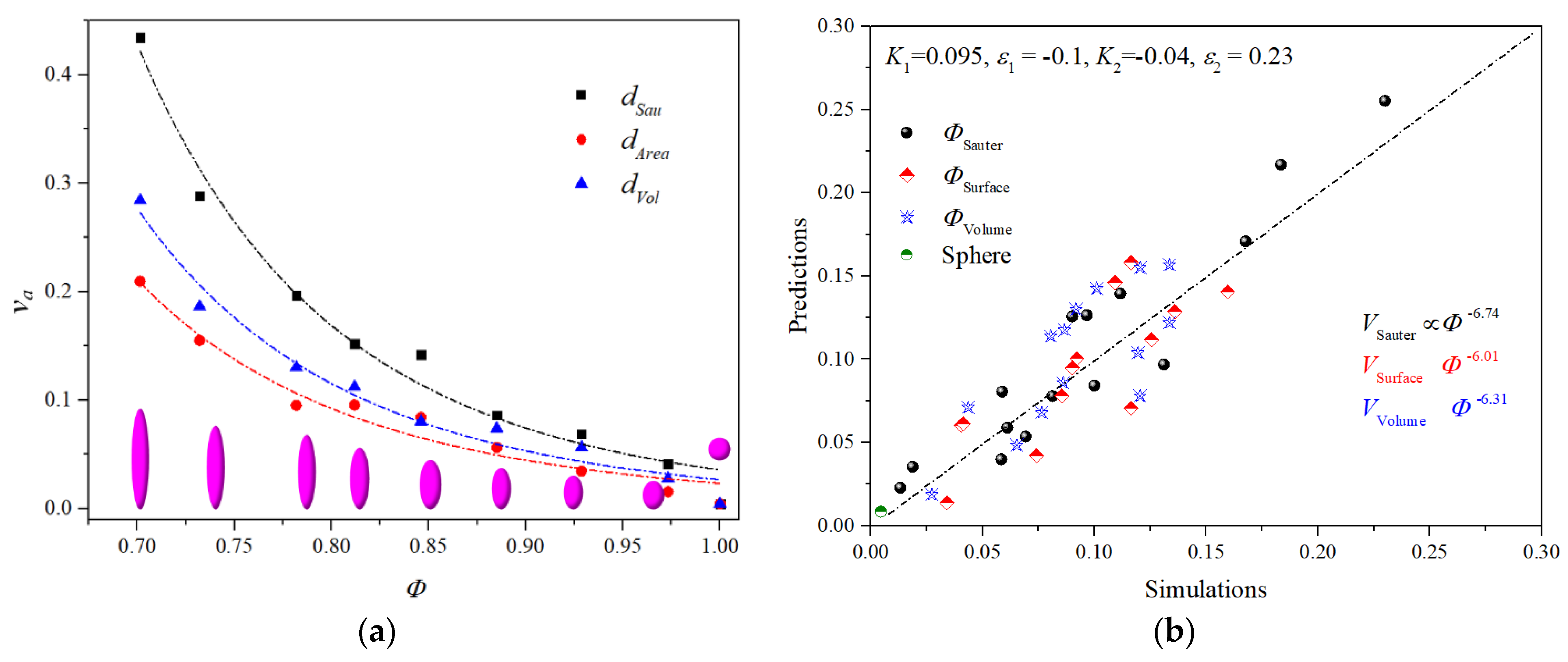
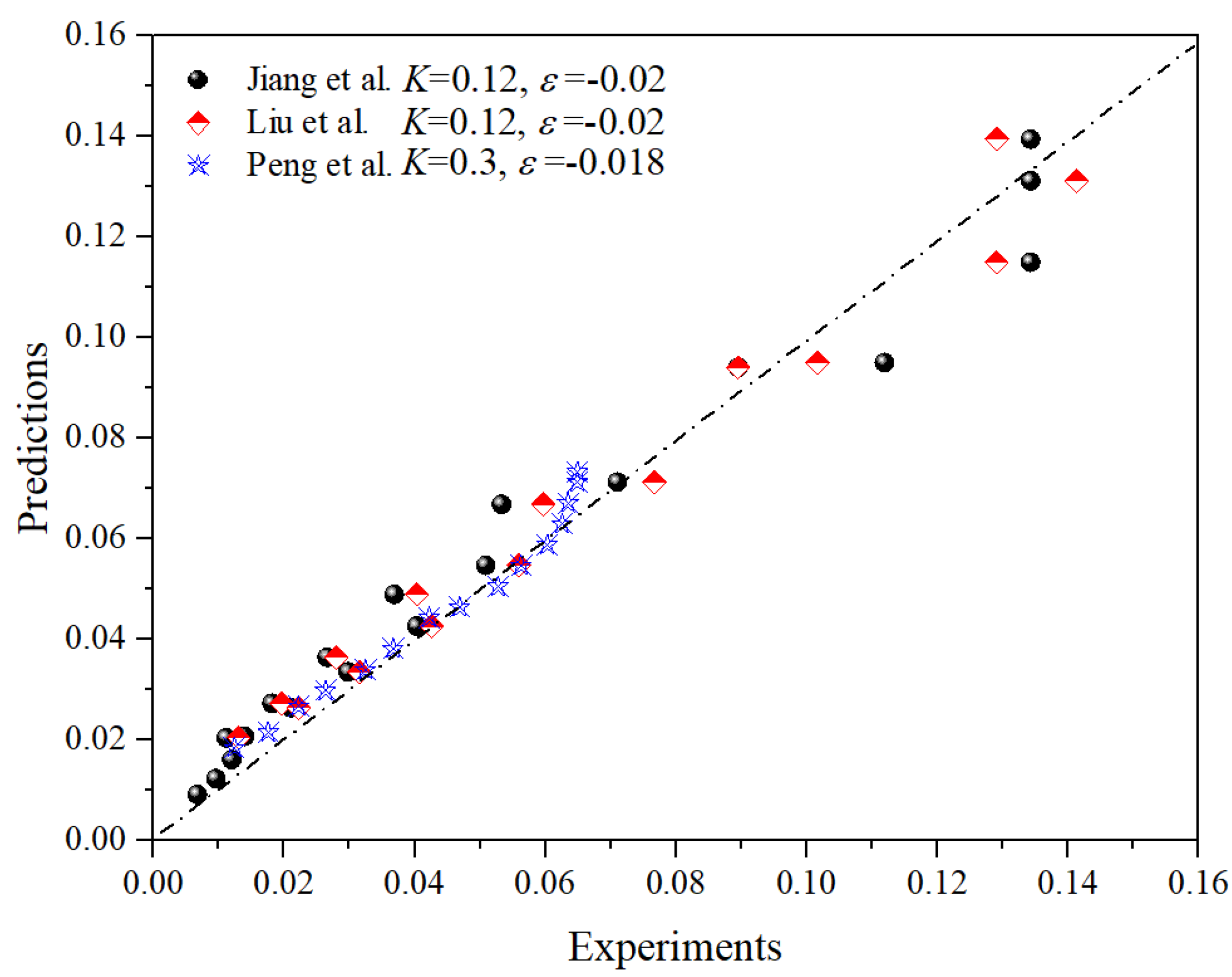
| Reference | Methodology | Investigated Parameters | Mathematical Model |
|---|---|---|---|
| Liffman et al. [22] | Experiment 2D | A = 15 mm f = 4–5 Hz Γ = 0.6–11 | |
| Jiang et al. [31] | Experiment 3D | f = 60 Hz Γ = 2.5–11 | |
| Peng et al. [32] | Experiment 3D | f = 60 Hz Γ = 1.5–11 | |
| Liu et al. [33] | Experiment 3D | f = 60 Hz Γ = 2–11 |
| Parameters | Value of Parameter |
|---|---|
| Poisson’s ratio of particles | 0.25 |
| Poisson’s ratio of container base | 0.29 |
| Young’s modulus of particles (Pa) | 2.01 × 105 |
| Young’s modulus of container base (Pa) | 2.55 × 1010 |
| Coefficient of restitution: particle–particle | 0.5 |
| Coefficient of static friction: particle–particle | 0.5 |
| Coefficient of rolling friction: particle–particle | 0.01 |
| Coefficient of restitution: particle–base | 0.5 |
| Coefficient of static friction: particle–base | 0.5 |
| Coefficient of rolling friction: particle–base | 0.01 |
| Intruder equivalent diameter, dl (mm) | 6.0 |
| Intruder shape | Ellipsoid, spherical |
| Intruder aspect ratio, a/b | varies in [1.0, 5.75] |
| Diameter of small particles, ds (mm) | 2 |
| Diameter ratio, dr = dl/ds | 3.0 |
| Particle density: Large (Intruder), ρl (kg/m3) | 2500 |
| Particle density: Small, ρs (kg/m3) | 2500 |
| Density ratio, ρl/ρs | 1.0 |
| Number of large particles (intruder) | 1 |
| Number of small particles | 15,200 |
| Vibration amplitude A (mm) | 1–5 (0.5·ds–2.5·ds) |
| Vibration frequency f (Hz) | 20–80 |
| Equivalent Ways (dl = 6 mm) | Axial Size (mm) | Sphericity, Φ | |||||||
|---|---|---|---|---|---|---|---|---|---|
| 0.97 | 0.93 | 0.89 | 0.85 | 0.81 | 0.78 | 0.73 | 0.70 | ||
| dVol | a | 3.93 | 4.76 | 5.53 | 6.24 | 6.91 | 7.56 | 8.77 | 9.63 |
| b | 2.62 | 2.38 | 2.21 | 2.08 | 1.97 | 1.89 | 1.75 | 1.67 | |
| dArea | a | 3.88 | 4.59 | 5.20 | 5.74 | 6.23 | 6.68 | 7.50 | 8.06 |
| b | 2.59 | 2.30 | 2.08 | 1.91 | 1.78 | 1.67 | 1.50 | 1.40 | |
| dSau | a | 4.04 | 5.13 | 6.24 | 7.38 | 8.52 | 9.67 | 11.98 | 13.72 |
| b | 2.69 | 2.57 | 2.50 | 2.46 | 2.43 | 2.42 | 2.40 | 2.39 | |
| No. | fd | Ad | dl/ds | a/b |
|---|---|---|---|---|
| 1 | 0.40 | [0.5, 2.25] | 3 (dSau) | 2.0 |
| 2 | 0.40 | [0.5, 2.25] | 3 (dArea) | 2.0 |
| 3 | 0.40 | [0.5, 3.50] | 3 (dSau) | 4.0 |
| 4 | 0.40 | [0.25, 2.25] | 3 (dArea) | 3.0 |
| 5 | [0.20, 1.61] | 0.5 | 3 (dSau) | 3.0 |
| 6 | [0.20, 1.61] | 1.0 | 3 (dSau) | 3.0 |
Publisher’s Note: MDPI stays neutral with regard to jurisdictional claims in published maps and institutional affiliations. |
© 2021 by the authors. Licensee MDPI, Basel, Switzerland. This article is an open access article distributed under the terms and conditions of the Creative Commons Attribution (CC BY) license (http://creativecommons.org/licenses/by/4.0/).
Share and Cite
Qiao, J.; Dong, K.; Duan, C. DEM Study on the Segregation of a Non-Spherical Intruder in a Vibrated Granular Bed. Processes 2021, 9, 448. https://doi.org/10.3390/pr9030448
Qiao J, Dong K, Duan C. DEM Study on the Segregation of a Non-Spherical Intruder in a Vibrated Granular Bed. Processes. 2021; 9(3):448. https://doi.org/10.3390/pr9030448
Chicago/Turabian StyleQiao, Jinpeng, Kejun Dong, and Chenlong Duan. 2021. "DEM Study on the Segregation of a Non-Spherical Intruder in a Vibrated Granular Bed" Processes 9, no. 3: 448. https://doi.org/10.3390/pr9030448








